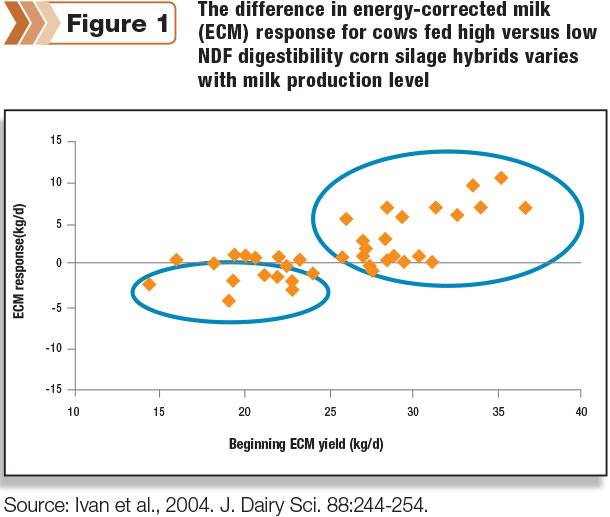High-quality forage makes more milk and milk components, boosts longevity and increases income over feed cost. The well-established relationship between forage digestibility and dairy cow performance is that each 1 percentage-unit increase in NDF digestibility translates into 0.39 pounds per day more dry matter intake and 0.55 pounds per day more 4 percent fat-corrected milk.
However, a cow’s response to NDF digestibility is a function of her milk production level and stage of lactation.

Figure 1 shows the response to higher corn silage NDF digestibility when cows were fed TMRs containing either higher- or lower-fiber digestibility hybrids. Higher-producing cows responded much more positively than lower-producing cows; lower producers did not respond, or even responded negatively, to greater forage NDF digestibility.
Understanding fiber digestibility and indigestibility
Fiber digestibility and indigestibility are critical factors when assessing forage quality and formulating diets. Fiber digestibility influences feeding and rumination behavior, rumen fill, dry matter intake and overall efficiency of milk component output. Nutritionists have focused primarily on measures of fiber digestibility, but recently, the focus has included indigestible fiber as well because of the recognition of its importance in setting the extent and influencing the rate of fiber fermentation in the rumen.
For purposes of nutritional modeling, indigestible NDF is required as the end point for fermentation to allow accurate estimation of the potentially digestible NDF fraction and its rate of digestion.
Dr. Dave Mertens has coined the term “undigested NDF” (uNDF) as the laboratory measure (typically in vitro or in situ) of indigestible NDF at a specified fermentation time, reported on an ash-free basis. The currently recommended method requires 240 hours of in vitro fermentation using a Tilley-Terry system (i.e., test-tube artificial rumens).
With the advent of a so-called three-pool model for NDF digestion, we are entering a new era in our ability to accurately formulate diets and predict cow response to forage. With this new approach, the three fiber pools are: fast-digesting NDF, slow-digesting NDF and undigested NDF.
Potentially digestible NDF is NDF minus uNDF. The uNDF fraction is variable and highly responsive to forage genetics and their growing conditions. Consequently, forage testing labs have begun measuring uNDF to more accurately assess the nutritive value of the forage.
Fast and slow NDF exists in all forages: legumes, grasses, corn silage and other grain-containing forages. The bottom line is that high-NDF digestibility forages have: more fast-pool NDF, less slow-pool NDF and less uNDF.
Forage labs are beginning to measure these fractions routinely. Being able to better characterize the actual digestion profile of forage fiber will allow us to do a better job of formulating diets.
Forage digestibility and feeding time
Forage NDF digestibility has an important impact on eating and ruminating time. In studies at Miner Institute, we have observed up to an hour per day difference in eating time between cows fed lower-forage, higher-NDF digestibility diets versus higher-forage, lower-NDF digestibility diets. Feeding BMR versus conventional corn silage has resulted in a half-hour per day difference in eating time.
When eating, cows tend to chew forages to a common particle size before swallowing, and slower-fermenting forage NDF takes longer to process. As forage digestibility declines, there are serious time budget challenges at the feedbunk, especially when cows are overstocked. This is particularly true for younger cows that cannot process forage fiber as effectively as mature cows.
We must be sure that feedbunk and pen management provide sufficient time for the cows to eat and effectively ruminate the forage in the diet as NDF quality and amount vary.
Current insights into NDF and uNDF intake targets
At Miner Institute, we have evaluated diets with a substantial range in corn and haycrop silage source and amounts. Diets have ranged between 36 and 55 percent corn silage (dry matter basis), have contained conventional versus BMR corn silage that varied by 10 percent units in NDF digestibility, and some diets have contained up to 10 percent added chopped straw to maintain chewing activity as forage percentage was reduced from 52 to 39 percent.
Overall, diets contained between 39 and 68 percent total forage.
Based on these studies, here are some preliminary targets and ranges for NDF intake that are applicable to highly productive dairy cows (approximately 55 pounds per day dry matter intake and 90 to 100 pounds per day milk production) fed diets based on corn silage, haycrop silage and chopped dry alfalfa hay. Note that all NDF values are expressed as amylase-modified, sodium sulfite-treated and ash-corrected NDF:
- Maximum dietary NDF intake is approximately 1.47 percent of bodyweight (BW) (range of 1.26 to 1.47)
- Maximum rumen NDF is about 1.28 percent of BW
- Range dietary uNDF240 intake is 0.25 to 0.48 percent of BW
- Range in uNDF mass in rumen is 0.48 to 0.62 percent of BW
- Ratio of rumen uNDF to intake uNDF is approximately 1.60 regardless of diet
These relationships are a starting point to begin implementing what we have learned recently about fiber digestibility in the field. As more research and on-farm observations accumulate, these recommendations can be adjusted.
What’s coming down the road
We are quickly entering a new era in our ability to measure forage NDF digestion characteristics and to accurately model cow response to forage quality. The uNDF fraction is the “ballast” that serves as an intake constraint. The relative proportions of the fast and slow NDF determine the flux of NDF through the rumen. In particular, the uNDF plus the slow NDF likely govern rumen space available and, consequently, dry matter intake.
The proportion of fast and slow NDF within a forage or diet determines the relationship between digestion rate, rate of particle breakdown and passage from the rumen. We should be able to optimize efficiency of feed use by identifying the optimal ratio of fast NDF to slow NDF to uNDF.
Over a fairly wide range of dietary forages, the ratio of rumen to intake uNDF seems to be about 1.60. In other words, uNDF in the rumen is about 1.6 times the uNDF in the diet. If the cow eats more uNDF, then there is more uNDF in the rumen, up to a maximum amount.
We are close to developing an improved system for accurately determining intake and rumen fiber turnover based on assessment of fast NDF, slow NDF and uNDF. We still need to tackle how best to model forage passage. Stay tuned – it is an exciting time to be feeding forage to dairy cows. PD

-
Rick Grant
- William H. Miner Agricultural Research Institute
- Email Rick Grant








